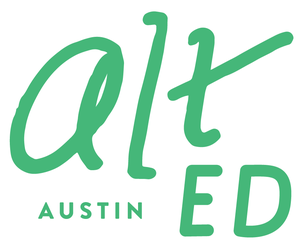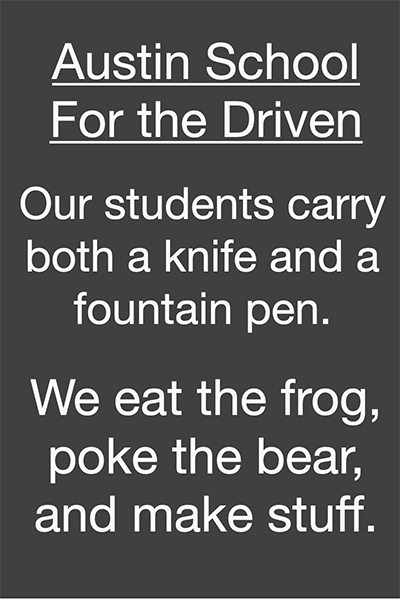Top 5 reasons why teens make great entrepreneurs
/Sarah Hernholm, lead contributor of this guest post, is the founder/president of WIT—Whatever It Takes, the only six-unit college-credit social entrepreneur and leadership course in the country for high school teens. Based in San Diego, WIT has locations in St. Louis, New York, and now Austin. WIT is currently accepting applications for 2016–2017; visit www.doingwit.org to learn how. To view Sarah’s TEDx talks and read more of her thoughts on why teens rock, check out www.sarahhernholm.com. You can follow her on Twitter @miss_wit.
Also contributing to this piece were teen entrepreneurs Safi Jafri, founder of WhiteHat; Daniela Montes, president of Student 2 Student Art (S2S); and Andrew Castro, president of Choose You.
Rebellious.
Willful.
Out-of-the-box.
These are just a few words to describe two groups of people: teens and entrepreneurs.
Over the last six years, through my company WIT—Whatever It Takes, I’ve spent my days working with teens and helping them become entrepreneurs and leaders in their communities. The work isn’t always easy (because of those words mentioned above), but it certainly is rewarding to see teens become more confident, empathetic, self-aware, and successful.
And since I think most experiences are better with teens, when I was asked to write this Top 5 list, I went to teens and asked them to chime in with their reasons as to why they make great entrepreneurs. Check out some of their thoughts below.
1. Teens want to do something. I know the common societal narrative is that teens are apathetic and self-absorbed (although I think I know more adults than teens who fit that description!), what I see on a regular basis are teens who are frustrated by what is happening in their world and interested in figuring out how to make “it” better. What usually holds them back is the lack of programs/platforms available to them and those countless hours of ridiculous homework (but that’s a topic for another blog). Yet at WIT we see teens finding ways to launch a social enterprise despite their heavy school workloads. Why? Because they are passionate about doing work that actually matters to them.
2. Teens like proving you (adults) wrong. If I wanted to apply reverse psychology on teens, I would just say, “I don’t think you can build a company,” and I know that would only fuel them to do it. But I don’t take that approach. I don’t have to. Society is already doing it. As teen Safi Jafri puts it, “. . . that teenage mind that people say can't ever be professional enough or smart enough or mature enough? Well that mind will do whatever it takes to get what they want, no matter how little you believe in their potential . . .” Just because they don’t want to do their homework doesn’t mean they don’t want to change the world. Proving doubters wrong is a common motivation for successful entrepreneurs. As teen Andrew Castro says, “We love to prove people wrong and push the envelope.”
3. Teens aren’t carrying a lot of baggage. As teen Pia Deshpande shared with me, “ . . . most teenagers haven't defined themselves as people yet. They never sit back and say, ‘That's not me’ like so many adults do . . . they're still exploring . . .” In other words, teens aren’t as cynical and hardened as most adults; they haven’t labeled themselves or put themselves in boxes like a lot of adults do. Also, the majority of teens don’t have a mortgage, lots of bills, debt, or dependents, so they are able to take on more risks—and being able to take risks is a great trait of an entrepreneur.
4. Teens want more “real world” experience. Most of a teen’s day is spent sitting and listening to someone tell them what they think is important. All of this is done in the hope of better preparing said teens for the “real world.” But last time I checked, I don’t spend my days sitting for 10 hours while someone talks at me. It doesn’t surprise me that teens experience burnout and want to ditch school. I would too (and did). Teens just want adults to acknowledge that the world they are living in is actually their “real world” and that they would prefer not to just talk about things in theory but instead apply the knowledge to their real world! This is why entrepreneurship is a great outlet: teens can apply math, reading, writing, public speaking, debate, etc., all while running their own business!
5. Teens want reasons to believe in themselves. Teen Daniela Montes shared with me: “At an age where insecurity is common, building entrepreneurial skills allows us to believe in ourselves and say, “Hey, I'm capable of making a difference,’ thus creating confidence, professionalism, and maturity.” Those teen years can be tough. It can be seven years of questioning your place, value, and worth and wondering if you measure up. But when you launch a business as a 16-year-old and see your efforts improve the lives of others and get recognized for your impact, you see proof that you matter and are changing lives. That tangible proof helps build confidence and self-worth, which all teens could use a little more of.
So to all those teens out there: I see you—your rebellious energy, willful determination, and desire to make a difference—and I applaud you for it!
And I want to invest in your enterprises . . . so hit me up.
Sarah Hernholm, with assistance from Safi Jafri, Daniela Montes, and Andrew Castro































